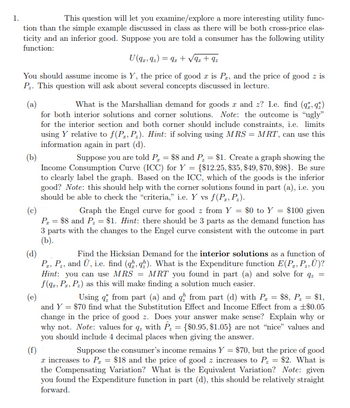
ENGR.ECONOMIC ANALYSIS
14th Edition
ISBN: 9780190931919
Author: NEWNAN
Publisher: Oxford University Press
expand_more
expand_more
format_list_bulleted
Question
help me solve part b) of this excersise.

Transcribed Image Text:1.
This question will let you examine/explore a more interesting utility func-
tion than the simple example discussed in class as there will be both cross-price elas-
ticity and an inferior good. Suppose you are told a consumer has the following utility
function:
U (9219₂) = 9z+√9z+ 9₂
You should assume income is Y, the price of good r is P2, and the price of good z is
P₂. This question will ask about several concepts discussed in lecture.
(a)
What is the Marshallian demand for goods x and z? I.e. find (qq)
for both interior solutions and corner solutions. Note: the outcome is "ugly"
for the interior section and both corner should include constraints, i.e. limits
using Y relative to f(P, P₂). Hint: if solving using MRS = MRT, can use this
information again in part (d).
(b)
Suppose you are told P₂ = $8 and P₂ = $1. Create a graph showing the
Income Consumption Curve (ICC) for Y = {$12.25, $35, $49, $70, $98). Be sure
to clearly label the graph. Based on the ICC, which of the goods is the inferior
good? Note: this should help with the corner solutions found in part (a), i.e. you
should be able to check the "criteria," i.e. Y vs f(P, P₂).
(c)
Graph the Engel curve for good z from Y = $0 to Y = $100 given
P₁ = $8 and P₂ = $1. Hint: there should be 3 parts as the demand function has
3 parts with the changes to the Engel curve consistent with the outcome in part
(b).
(d)
Find the Hicksian Demand for the interior solutions as a function of
Pr, P₂, and Ū, i.e. find (qq). What is the Expenditure function E(P, P₂, Ū)?
Hint: you can use MRS = MRT you found in part (a) and solve for q₂ =
f(qz, PT, P₂) as this will make finding a solution much easier.
(e)
Using from part (a) and q from part (d) with P₂ = $8, P₂ = $1,
and Y = $70 find what the Substitution Effect and Income Effect from a +$0.05
change in the price of good z. Does your answer make sense? Explain why or
why not. Note: values for q with P₂ = {$0.95, $1.05} are not "nice" values and
you should include 4 decimal places when giving the answer.
(f)
Suppose the consumer's income remains Y = $70, but the price of good
x increases to P₁ = $18 and the price of good z increases to P₂ = $2. What is
the Compensating Variation? What is the Equivalent Variation? Note: given
you found the Expenditure function in part (d), this should be relatively straight
forward.
Expert Solution
This question has been solved!
Explore an expertly crafted, step-by-step solution for a thorough understanding of key concepts.
This is a popular solution
Trending nowThis is a popular solution!
Step by stepSolved in 3 steps with 2 images

Knowledge Booster
Learn more about
Need a deep-dive on the concept behind this application? Look no further. Learn more about this topic, economics and related others by exploring similar questions and additional content below.Similar questions
Recommended textbooks for you

 Principles of Economics (12th Edition)EconomicsISBN:9780134078779Author:Karl E. Case, Ray C. Fair, Sharon E. OsterPublisher:PEARSON
Principles of Economics (12th Edition)EconomicsISBN:9780134078779Author:Karl E. Case, Ray C. Fair, Sharon E. OsterPublisher:PEARSON Engineering Economy (17th Edition)EconomicsISBN:9780134870069Author:William G. Sullivan, Elin M. Wicks, C. Patrick KoellingPublisher:PEARSON
Engineering Economy (17th Edition)EconomicsISBN:9780134870069Author:William G. Sullivan, Elin M. Wicks, C. Patrick KoellingPublisher:PEARSON Principles of Economics (MindTap Course List)EconomicsISBN:9781305585126Author:N. Gregory MankiwPublisher:Cengage Learning
Principles of Economics (MindTap Course List)EconomicsISBN:9781305585126Author:N. Gregory MankiwPublisher:Cengage Learning Managerial Economics: A Problem Solving ApproachEconomicsISBN:9781337106665Author:Luke M. Froeb, Brian T. McCann, Michael R. Ward, Mike ShorPublisher:Cengage Learning
Managerial Economics: A Problem Solving ApproachEconomicsISBN:9781337106665Author:Luke M. Froeb, Brian T. McCann, Michael R. Ward, Mike ShorPublisher:Cengage Learning Managerial Economics & Business Strategy (Mcgraw-...EconomicsISBN:9781259290619Author:Michael Baye, Jeff PrincePublisher:McGraw-Hill Education
Managerial Economics & Business Strategy (Mcgraw-...EconomicsISBN:9781259290619Author:Michael Baye, Jeff PrincePublisher:McGraw-Hill Education


Principles of Economics (12th Edition)
Economics
ISBN:9780134078779
Author:Karl E. Case, Ray C. Fair, Sharon E. Oster
Publisher:PEARSON

Engineering Economy (17th Edition)
Economics
ISBN:9780134870069
Author:William G. Sullivan, Elin M. Wicks, C. Patrick Koelling
Publisher:PEARSON

Principles of Economics (MindTap Course List)
Economics
ISBN:9781305585126
Author:N. Gregory Mankiw
Publisher:Cengage Learning

Managerial Economics: A Problem Solving Approach
Economics
ISBN:9781337106665
Author:Luke M. Froeb, Brian T. McCann, Michael R. Ward, Mike Shor
Publisher:Cengage Learning

Managerial Economics & Business Strategy (Mcgraw-...
Economics
ISBN:9781259290619
Author:Michael Baye, Jeff Prince
Publisher:McGraw-Hill Education